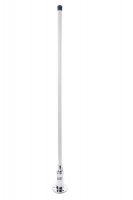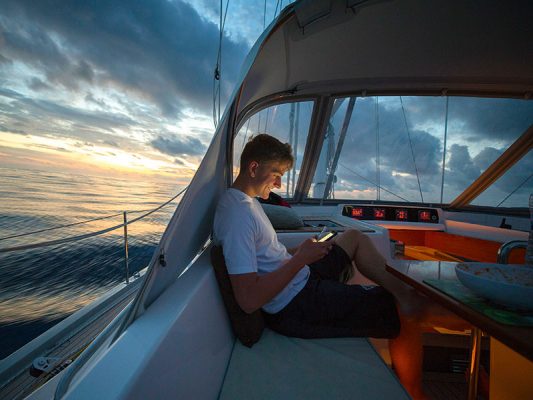The Internet has become an essential part of almost all our lives, so how can we keep connected when we’re afloat? Duncan Kent checks out various onboard methods of getting online
Excluding expensive satellite communication systems, there are two common ways a coastal cruiser can access the Internet while on board:
1. By receiving Wi-Fi signals from a marina or some other nearby open source
2. By using mobile Internet via GSM (2G/3G) or LTE (4G) cellular network.
The former is fine if you tend to stop each night in a marina and have a reasonable signal, and if you only want to do the occasional browsing and emailing. The second method is more suited to those who prefer to anchor off, or want to use it on the move.
What are they on about? PBO glossary of terms for Wifi on your boat
Next comes the choice of hardware you’ll use to access the Wi-Fi signal – and here’s where it becomes more complicated. If you’re in a marina you may just need a booster antenna to make best use of the available signal, or one that’ll search for the strongest local signal to patch into.
Or maybe you’ll need a router and booster if you intend to make use of more than one Wi-Fi enabled device at a time.
And if you’re at sea you’re probably going to need a router hub that make use of the mobile phone network. Read on to see what you’re going to need…
Guide to Long-range wifi boosters
For those with a single laptop or PC on board, all you need to boost marina Wi-Fi reception is a signal booster comprising a high-gain antenna (preferably waterproof) and a long cable, terminating in a USB connector. Plugging it into your PC simply overrides the internal Wi-Fi card; software supplied with the antenna will enable you to select and lock onto your preferred Wi-Fi hotspot.
High-gain antennae come in two types – directional and omni-directional. The former, usually a flat box with a simple flat plate or two inside, can be pointed towards the preferred signal source, effectively ‘tuning’ it to the transmitter, whereas the latter, frequently a tubular ‘pole’ type, doesn’t need to be aligned to any particular direction.
Alfa Tube-U
Price: £63
Contact: www.wifi-antennas.co.uk

This kit comprises two items – a 150Mbps, 2.4GHz long-range waterproof USB Wi-Fi dongle and a 2.4GHz high-gain (9dB) external omnidirectional pole antenna with cable and connectors.
The dongle and antenna connect together as one waterproof unit from which you run the supplied 5m-long cable (extensions available) down to your laptop and connect it directly via the USB plug. Power is taken from the laptop’s USB (2+) port.
Supports all recent Windows, Mac and Linux platforms. Range is said to increase to 4-5 miles using the Alfa Tube-U.
Digital Yacht WL70
Price: £180
Contact: www.digitalyacht.co.uk

This simple 1.3m-high omindirectional antenna comes with 5m of cable terminating in a USB plug.
Its threaded base fits a standard 1in VHF-type antenna mount and is fully waterproof for mounting outside. Operates with Windows Vista/7/8/10 or Mac OSX 10.4 to 10.10 (Yosemite).
The WL70 features a very high performance 15dBm antenna that
can provide connections up to half a mile depending upon conditions. The Realtek software displays all the available signals and their relative strengths allowing you to get the strongest.
Kuma long-range antenna
Price: £39.99
Contact: www.acdctv.co.uk

This ‘weatherproof’ plastic antenna comes with a 5m-long USB cable which also provides power. The box measures 220 x 80 x 40mm and can be wall- or pole-mounted. Once activated a small console appears allowing you to manually set up profiles for frequently used Wi-Fi sources. Selecting ‘search’ provides a list of every Wi-Fi signal source in range.
The console also has a signal strength meter that goes green when connected to the Internet.
The antenna is quoted as offering a 16dB gain, which is high compared to others that are mostly around 8dB.
Wi-Fi Bat antenna
Price: £359
Contact: www.mailasail.com
![]()
The Wi-Fi Bat is a 2W, waterproof, omnidirectional pole antenna that the manufacturer claims will enable you to lock onto Wi-Fi signals up to 10 miles away. This high-gain (8dB) antenna is 70cm high and comes with 15m of co-axial cable, terminating in a normal USB plug. Annoyingly the antenna isn’t compatible with a standard 1in VHF antenna screw base mount.
Power is supplied by the USB port and the software is supplied on a mini-CD.
This is a simple plug-and-play device that pretty much doubles the sensitivity of the laptop’s integral Wi-Fi card and enables usable Wi-Fi hotspots to be logged onto several miles away.
Digital Yacht WL510
Price: £594
Contact: www.digitalyacht.co.uk

This is a 90cm-long, high-gain (+12dB) omnidirectional antenna in a rugged (but not waterproof) aluminium box, measuring 170 x 100 x 55mm. The antenna is waterproof, so can be mounted outside on a standard 1in threaded base mount. The box has one PL259 antenna socket, a single RJ45 LAN socket and a 12/24V DC power cable.
Compatible with all popular operating systems the WL510 is configured via a browser and the control software is extremely good, though a little complex. Once powered up you scan for hotspots, select the one you want and then hit apply. The unit will give access to hotspots up to five miles away, depending on antenna height.





